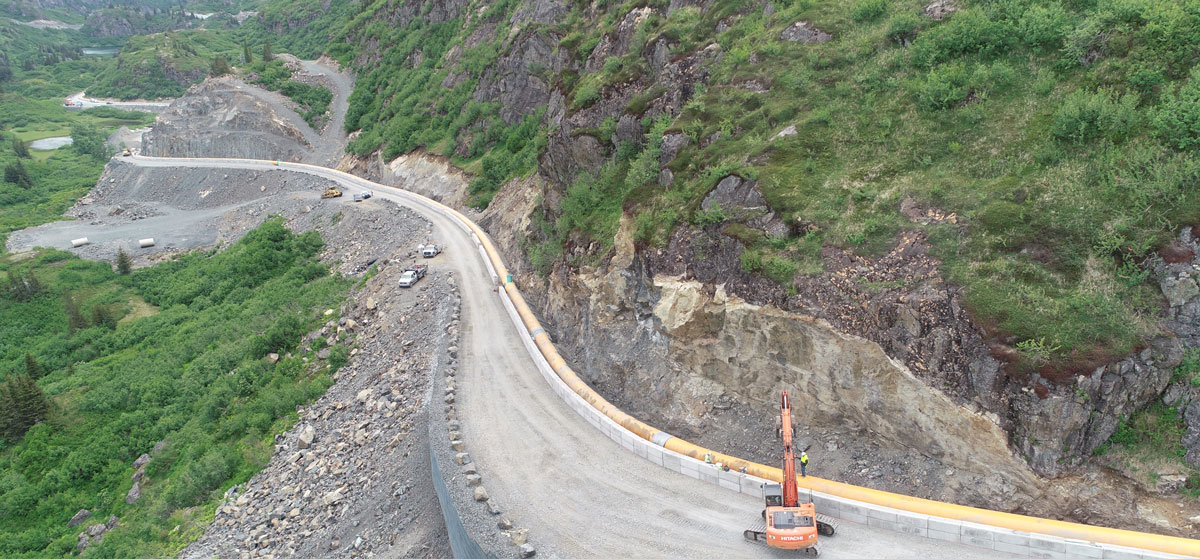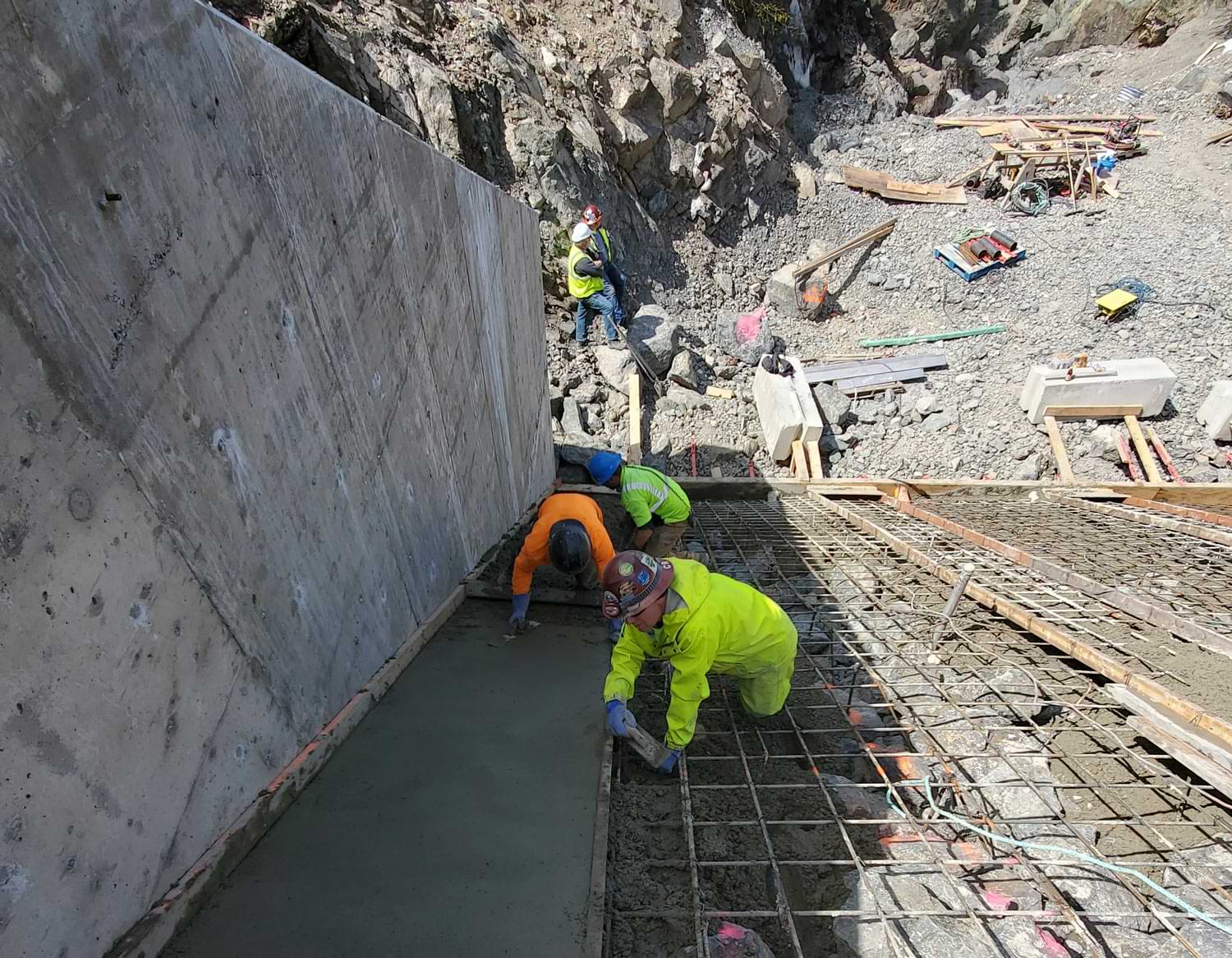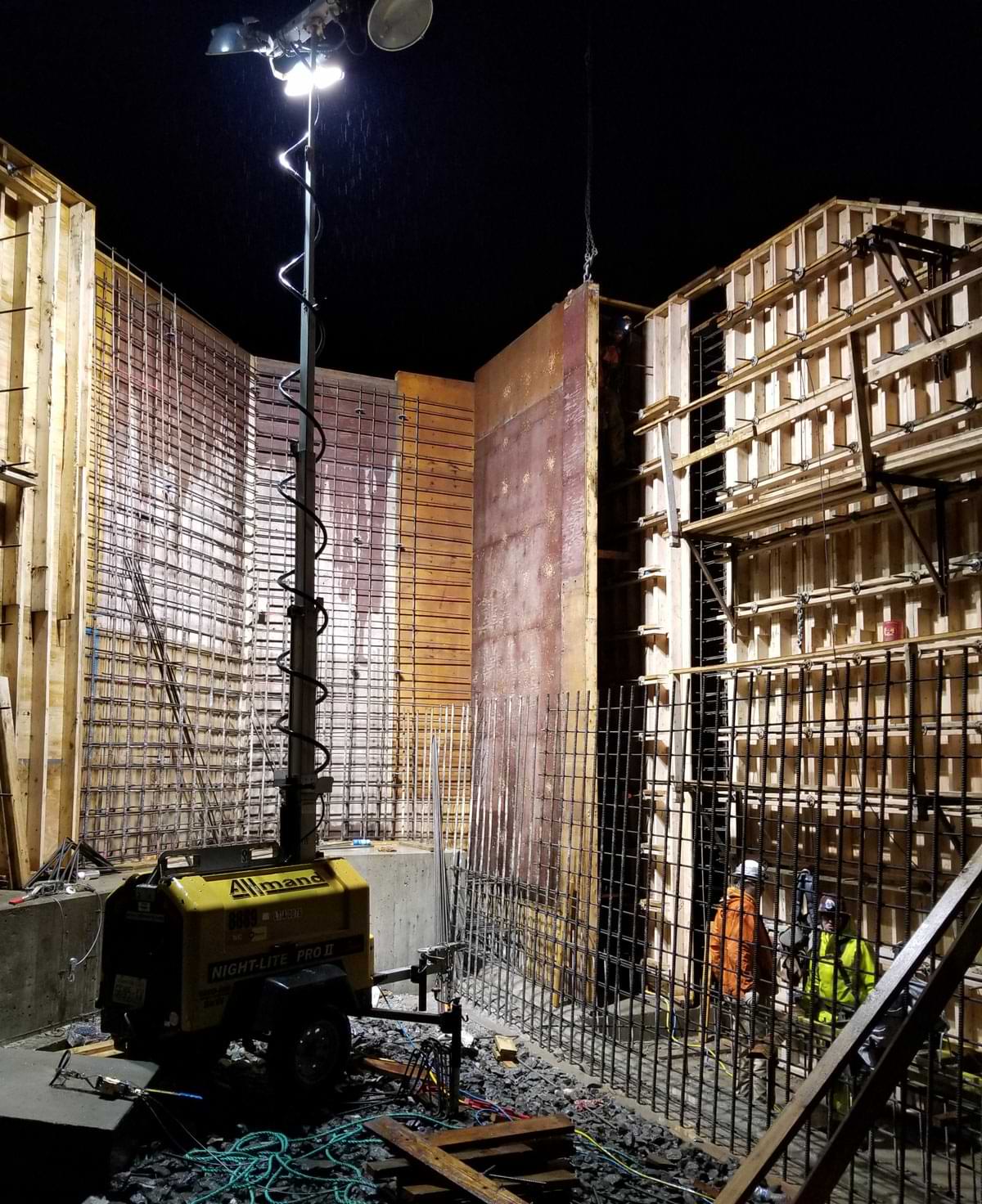Hydro Plant Power Output
This aerial photo shows the downstream face of the diversion concrete spillway on the right, sluice channel and instream flow water release at center and pipe intake below the excavator.
Photo courtesy of Alaska Energy Authority
ith the flip of a switch, a diverted glacier stream outside Homer began flowing into Bradley Lake’s hydroelectric plant last fall with the potential to increase the availability of low-cost power to customers as far away as Fairbanks.

This aerial photo shows the downstream face of the diversion concrete spillway on the right, sluice channel and instream flow water release at center and pipe intake below the excavator.
Photo courtesy of Alaska Energy Authority
ith the flip of a switch, a diverted glacier stream outside Homer began flowing into Bradley Lake’s hydroelectric plant last fall with the potential to increase the availability of low-cost power to customers as far away as Fairbanks.
Located 27 miles from Homer in the Kenai Mountains, the Bradley Lake Hydroelectric Plant provides some of the least expensive power in the state—approximately four cents per kilowatt hour—to utilities along the Railbelt electrical grid. Owned by the Alaska Energy Authority, or AEA, and operated by Homer Electric Association, the plant was energized in 1991 and began transmitting electricity to residents from Homer north to Fairbanks via two parallel 20-mile transmission lines that connect to a larger transmission system to move power north.
Diversion of the west fork of Upper Battle Creek into the lake enables the facility to increase its annual output by about 10 percent—enough power to light approximately 5,000 homes, according to AEA Executive Director Curtis W. Thayer.
“This increase reduces the need for the utilities to run gas-powered generators and slows down energy rate hikes from fuel prices,” says Thayer.


Pictured above: A McElroy Talon 2000, the world’s largest fusion machine, connects two sections of pipeline that will transport water from the new Battle Creek Diversion to Bradley Lake Dam.
Photo courtesy of DOWL Engineering
Inset: The world’s largest fusion welding machine from McElroy Industries was brought in from the Lower-48 to connect the sections of 37.5-foot, five-foot diameter pipe. The pipe was fused while held straight then curved to fit the roadway.
Photo courtesy of Alaska Energy Authority
Left: The five-foot diameter pipe lies buried alongside this meandering access road from the diversion site to Bradley Lake. Burying the pipe gives it protection from the sun, temperature and rock fall.
Photo courtesy of Alaska Energy Authority
Photo courtesy of DOWL Engineering
Inset: The world’s largest fusion welding machine from McElroy Industries was brought in from the Lower-48 to connect the sections of 37.5-foot, five-foot diameter pipe. The pipe was fused while held straight then curved to fit the roadway.
Photo courtesy of Alaska Energy Authority
Left: The five-foot diameter pipe lies buried alongside this meandering access road from the diversion site to Bradley Lake. Burying the pipe gives it protection from the sun, temperature and rock fall.
Photo courtesy of Alaska Energy Authority

Construction of the $47 million West Fork Upper Battle Creek Diversion Project began in May 2018 under the direction of general contractor Orion Marine Contractors, Inc. and finished on schedule in August 2020.
Orion and its subcontractors built three miles of roadway in the Kenai Mountains across Kachemak Bay and installed a concrete diversion dam, a two-mile pipeline 63 inches in diameter to carry water from Battle Creek to Bradley Lake, and associated infrastructure, according to Dave Banke, Orion’s director of operations.
The world’s largest track-mounted, high-density polyethylene (HDPE) fusion machine was brought in from the Lower 48 to connect each section of pipe—a first in Alaska construction.
Fusing the pipe was a two-step operation. First, the sections were barged to Bradley Lake, where two sections were fused. Then they were then trucked to the project site and fused using the McElroy Talon 2000.
This ranked as some of the largest-diameter HDPE pipe ever fused, and two technicians from the fusion machine manufacturer were on site the entire time the machine was working, according to a Battle Creek project fact sheet.
But it was access to the project site, rugged terrain, and finishing the project on time that posed the greatest obstacles.
All equipment, materials, and the man camp facility had to be barged across Kachemak Bay at exceptionally high tides occurring only at specific times during the year. But even then, the equipment and materials were still some seven miles from—and 1,500 feet below—the project site, according to the fact sheet.
The route to the diversion dam site was divided into two segments: a one-mile lower access road and a two-mile upper access road. Orion and subcontractor GMC Contracting built the lower road during the 2018 season but found the upper access road had to be redesigned because the existing topography was substantially different than originally thought. In order to maintain the timeline, Orion crews devised a bypass road while the upper road alternative was underway. The change called for an additional 50,000 cubic yards of rock to be drilled, shot, and excavated, according to the report.
Orion crew members work on placing and finishing concrete on top of the 20-foot riprap spillway at the diversion site.
Photo courtesy of Orion Marine Contractors Project Team

Orion crew members work on placing and finishing concrete on top of the 20-foot riprap spillway at the diversion site.
Photo courtesy of Orion Marine Contractors Project Team
To meet the October 2020 demobilization deadline, Orion and its subcontractors called on crews to continue working during the winter of 2019-2020.
“The team worked through the winter season under extremely adverse conditions to complete the intake and outfall structures,” the report states.
Equally as important as installing infrastructure is connecting all the components. That’s where TecPro Ltd enters the project.
The Anchorage-based industrial electrical contractor provided power and fiberoptic communications lines along the access road from the new diversion site down to the power house at the dam, says Wes Saunders, TecPro’s co-founder who currently serves as project manager.
That gives operators the capability of opening, closing, and monitoring the whole diversion system from the power house, a distance of approximately eight miles, says Saunders.
Saunders deemed the project “impressive.”
The team of Orion, GMC, DOWL and TecPro knocked out a tremendous amount of work in just the last closing months, says Saunders.
“I know we spun heads with what we did—what the whole team accomplished. And to be honest, it really shows the determination and grit of the Alaskan workforce to be able to step up to what clearly was an impossible challenge and succeed to meet a timely finish,” he says.
Orion crews pull a night shift constructing forms for the diversion and intake concrete structure.
Photo courtesy of Orion Marine Contractors Project Team
- Eklutna Hydroelectric project—co-owned by Chugach Electric Association, Matanuska Electric Association, and the Municipality of Anchorage. Supplies approximately 40 megawatts to members in Anchorage and the Mat-Su Borough and is typically the least expensive power resource on the system.
- Cooper Lake Hydroelectric project located on the Kenai Peninsula. Owned by Chugach Electric Association.
- MEA is also served by several small, in-river hydro facilities built and run by independent power producers. Other potential hydro projects on the Railbelt system are currently in various stages of analysis by both utilities and the state.

Orion crews pull a night shift constructing forms for the diversion and intake concrete structure.
Photo courtesy of Orion Marine Contractors Project Team
- Eklutna Hydroelectric project—co-owned by Chugach Electric Association, Matanuska Electric Association, and the Municipality of Anchorage. Supplies approximately 40 megawatts to members in Anchorage and the Mat-Su Borough and is typically the least expensive power resource on the system.
- Cooper Lake Hydroelectric project located on the Kenai Peninsula. Owned by Chugach Electric Association.
- MEA is also served by several small, in-river hydro facilities built and run by independent power producers. Other potential hydro projects on the Railbelt system are currently in various stages of analysis by both utilities and the state.
The Battle Creek Diversion project is the largest improvement to the Bradley Lake Hydroelectric Plant since commercial operation began in September 1991.
The plant is managed by the Bradley Lake Project Management Committee, or BPMC, which was created to ensure all participants have a voice. The BPMC is comprised of a member from each participating organization in the project, including plant owner AEA, plant operator Homer Electric Association, and other purchasing public-power utilities: Chugach Electric Association, Golden Valley Electric Association, Matanuska Electric Association and the City of Seward, says Tony Izzo, chair of BPMC and chief executive officer of MEA.
Drilling to blast a passable road to the diversion site needed to continue through harsh winter conditions in order to make the August 2020 completion date.
Photo courtesy of Orion Marine Contractors Inc.
“Each utility owns a different percentage of the output of the project and currently make their own decisions on how and when to best use their share for their members,” says Izzo.
The Battle Creek Diversion project was financed through AEA, and the utilities will pay back principle and debt service over time, Izzo says.
“The BPMC makes decisions and sets direction for the project to ensure the optimization of the project for the benefit of the approximately 600,000 Alaskans we serve on the Railbelt electric system,” he says.
The Bradley Lake Hydroelectric Plant helps to make the most efficient use of thermal generation, reducing the amount of fossil fuels used to produce power for members served by the Railbelt system, says Izzo.

Drilling to blast a passable road to the diversion site needed to continue through harsh winter conditions in order to make the August 2020 completion date.
Photo courtesy of Orion Marine Contractors Inc.
“Each utility owns a different percentage of the output of the project and currently make their own decisions on how and when to best use their share for their members,” says Izzo.
The Battle Creek Diversion project was financed through AEA, and the utilities will pay back principle and debt service over time, Izzo says.
“The BPMC makes decisions and sets direction for the project to ensure the optimization of the project for the benefit of the approximately 600,000 Alaskans we serve on the Railbelt electric system,” he says.
The Bradley Lake Hydroelectric Plant helps to make the most efficient use of thermal generation, reducing the amount of fossil fuels used to produce power for members served by the Railbelt system, says Izzo.
“The Battle Creek Diversion allows us to increase those benefits and, since it utilizes the majority of the same infrastructure, it maximizes the cost/benefit ratio even further,” he says.
TecPro’s Saunders agrees.
“I think it’s pretty creative to take a flow from a stream that normally wouldn’t flow into the lake and then be able to boost your power production off the water available,” says Saunders. “Hydroelectric is certainly a great way to generate electricity in my mind. I don’t know of a better one.”
- City of Unalaska wind power feasibility—$139,000
- Nuyakuk River run-of-river hydro project (Dillingham)—$1 million
- Naknek wind and solar power feasibility and conceptual design—$103,500
- Cordova hydro storage assessment reconnaissance and feasibility—$294,462
- Goodnews Bay wind energy feasibility and conceptual design—$128,250
- Kotlik wind energy feasibility and conceptual design—$237,500
- Improved airfoil for wind turbines construction (Kongiganak)—$108,000
- Shungnak heat recovery expansion construction—$1.3 million
- Kotzebue community-scale energy storage system —$325,000
- Water Supply Creek hydro final design (Hoonah)—$461,474
- Walter Northway School wood chip heating system construction (Northway)—$650,000